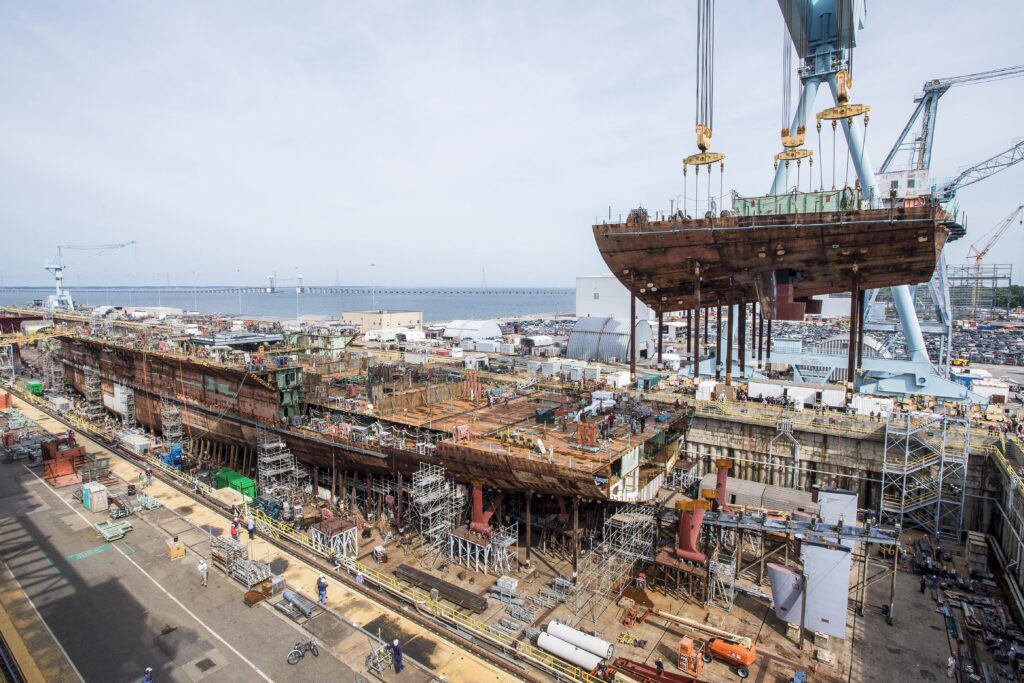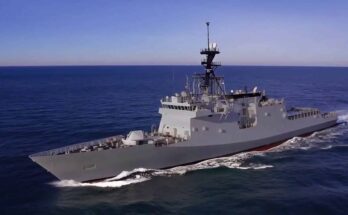 Source: U.S. Defense Department
Source: U.S. Defense DepartmentSince the reimposition of 25% tariffs on imported steel and aluminum by President Donald Trump in early 2025, the U.S. shipbuilding industry has found itself at a critical juncture. Originally introduced during Donald Trump’s presidency in 2018 and reinstated during his second term, the 25% tariff on steel aims to protect American manufacturing and reduce reliance on foreign materials. While the administration touts these tariffs as a means to bolster domestic manufacturing and national security, the tariffs will undoubtedly create ripple effects for the U.S. shipbuilding industry.
Steel: The Backbone of Shipbuilding
Steel is the foundational material in nearly every component of a modern ship, from the hull and superstructure to internal support systems. American shipbuilders rely on a steady supply of high-grade steel to build critical naval vessels like destroyers, aircraft carriers, and submarines. While the U.S. does produce significant amounts of steel domestically, specialty alloys and certain grades still come from global partners, including allies like Canada, the United Kingdom, and the European Union.
Rising Costs and Shifting Supply Chains
While the tariffs incentivize domestic production, they also increase the cost of imported steel, which would raise overall material costs for shipbuilders unless they adjust their supply chains. Shipbuilders may also face difficulties in sourcing sufficient quantities of steel domestically. Overall, the escalation in expenses could strain the Navy’s budget, and shifting supply chains could potentially slow shipbuilding and maintenance schedules, which are already substantially delayed. As a result, manufacturers are bracing for the impact of the tariffs, which could drive up operational and supply costs for those relying on steel inputs. As prices rise, shipyards are faced with tough decisions: delay projects, absorb costs, pass them on to buyers, or reduce their workforce. The latter option would be unlikely but particularly problematic given the already-strained demand for skilled labor in the shipbuilding industry.
Implications for Fleet Expansion
The steel tariffs also come at a time when the Navy plans to expand its fleet in order to counter growing maritime threats, especially in the Indo-Pacific region. The U.S. Navy’s shipbuilding targets have fluctuated, but the current goal is a fleet of 381 battle force ships (i.e., the number of commissioned ships or other ships that contribute directly to Navy warfighting or support missions). However, despite nearly doubling its shipbuilding budget over the last two decades, the Navy has not increased its number of battle force ships. For decades, private industry has struggled to meet the Navy’s goals for increasing the size of its fleet. This has contributed to the Navy’s shipbuilding programs being consistently over budget and behind schedule. Estimated delays for some ships, including the Constellation-class frigate program, are as much as three years. Moreover, the Navy’s Virginia-class submarine program is already projected to cost $17 billion over its initial budget by 2030. Higher steel prices would likely increase already elevated shipbuilding costs and exacerbate existing difficulties in meeting the 381-ship goal.
Implications for AUKUS
The AUKUS pact between Australia, the United Kingdom, and the United States could also be affected. The pact, aimed at enhancing security in the Indo-Pacific region, involves the U.S. supplying nuclear-powered submarines to Australia. However, the tariffs threaten to derail this initiative by increasing production costs and straining relationships with key allies. Senator Tim Kaine (D-VA), a member of the Senate Armed Services Committee, highlighted that 35% of the materials used in U.S. shipbuilding come from allies such as the UK, Canada, and European nations. Senator Kaine also warned that these tariffs could undermine the AUKUS partnership by increasing submarine production costs and delaying delivery of nuclear-powered submarines promised to Australia as part of the pact. This could ultimately strain the trilateral relationship and complicate a key U.S. foreign policy objective aimed at countering China’s growing naval presence in the Indo-Pacific.
Conclusion
The reimposition of steel tariffs in 2025 has brought renewed attention to the shifting balance between enhancing domestic steel production and raising costs for shipyards, both of which carry implications for international defense collaborations. While the long-term impacts remain to be seen, stakeholders across government and industry continue to evaluate how best to align trade policy with broader goals, including job creation, industrial competitiveness, and national security concerns. Ongoing discussions around targeted exemptions, supply chain flexibility, and allied cooperation may shape how the shipbuilding sector adapts moving forward. The relationship between steel tariffs and shipbuilding capacity will most certainly remain a topic of active policy debate and industry focus.
image sources
- Shipbuilding: U.S. Defense Department




